Well, better late than never, as they say. This is one loooooooong overdue Close-up, but, trust me, it’s going to be a good one because it’s with none other than our super-talented site contributor, @Aproned Artist, aka Samantha Yacovetta. You probably know her as the creative force behind our monthly blog feature, “Every Little Detail with Aproned Artist”, where she consistently stuns us with her incredible attention to the tiniest of details. (If you haven’t yet read her tutorials, you should! You can find them all here.)
But now, it’s time to get to know Samantha beyond her Cookie Connection persona. Of course, we’re going to talk cookies here, but I’m going to stray occasionally into non-cookie territory as well! Ready? Let’s go!
![]()
JMU: Hi, Samantha! Again, my apologies for taking so long getting this interview off the ground. I typically like to interview all site contributors within a couple of months of them joining our team, in order to give members the opportunity to get to know them better. But it seems I’ve been running perpetually behind schedule for the last two years . . . I DID, however, manage to do a live chat with you back in February 2017 as part of our “Rising Star” series, before you started writing tutorials for us. (In other words, I’m not a complete slacker! ![]() ) And that chat happens to be a great launching pad for this conversation!
) And that chat happens to be a great launching pad for this conversation!
At that time, you had just left a job at a bakery in California and had started a cottage food operation (CFO) making cookies out of your home. But let’s rewind a bit . . . what led you to that job in the bakery? Had you always had an interest in baking and cookies, or did you come to that interest later in life? What were you doing prior to starting work in the bakery, and what precipitated your move to bakery work?
![]()
SY: Hi, Julia. Thank you for such a glowing introduction! My interest in baking began almost 20 years ago when I left my job in the pharmaceutical industry to stay home with my two kids. As they grew older and more rambunctious, I turned to crafts and baking in a desperate attempt to keep them entertained. Baking, I found, was the perfect activity for small kids - messy, tactile, and edible. We had so much fun!
By the time I was considering going back to work, we’d become pretty accustomed to living on a single income. My (super supportive) husband encouraged me to find an industry that I really loved. I was just about to submit an application to the San Francisco Baking Institute when a bakery opened a few blocks from my house. It felt like a perfect opportunity to try out the field before I committed to going back to school.
![]()
JMU: I understand that you made more than cookies at the bakery. So, when did you decorate your first cookie and what prompted you to do so? Were you immediately hooked on cookies, or did it take a while for them to win you over?
![]()
SY: Initially, I made everything but cookies at the bakery. One day a customer came in with pictures of some beautiful princess cookies she’d found on the internet; I’d never seen anything like them. Before I knew what had happened, the owner accepted her order (meaning I had about a week to figure out how to make something similar). I was limited to white chocolate and marshmallow fondant, which further complicated the task. Ultimately, my cookies were nowhere near the caliber of those in the customer’s pictures, but she was overjoyed nonetheless. Here’s a (very blurry) picture of my first cookies:
I was hooked immediately. I began researching and practicing with online tutorials. (This is when I discovered Cookie Connection and began lurking as a non-member.) When I gained more confidence, the owner of the bakery generously allowed me to use the kitchen during off-hours to make cookies and then sell them in the store.
![]()
JMU: Wow! I love seeing cookie-firsts! What a remarkable evolution you've had, especially in such a short period of time! Thanks for sharing.
You mentioned in the chat that you left the bakery because it went out of business. So, why did you start your own home-based cookie business in 2016 rather than going to work for another bakery or opening your own brick-and-mortar shop? (Or doing something else for that matter?! It couldn’t have been reassuring to launch a bakery business after having just witnessed another one close.)
![]()
SY: Truthfully, I started my cookie business for all the wrong reasons. I was becoming obsessed with cookie decorating, and the bakery’s closure meant the end of my current cookie-selling avenue. So starting my own business was really just an excuse to make more cookies.
![]()
JMU: You then worked from your home, taking custom cookie orders, for about two years . . . is that right? Can you tell us what your biggest challenges were in launching your home-based cookie business, and how you got past them?
![]()
SY: Initially, transitioning to a CFO went pretty seamlessly. I had a loyal customer base from the bakery and good word-of-mouth advertising. Cookies were actually far easier to make at home - I didn’t have to contend with the heat and humidity of the bakery kitchen; I could decorate sitting down (such a luxury!); and I could better control the environment (no more surprise sesame seeds in my icing). As I’ve confessed before, I’m super shy, so interfacing with customers was definitely a new challenge. At the bakery, I rarely made customized sets. I usually made seasonal designs that were sold as individual items. So I was a little taken aback with some of my customers’ requests. It was uncomfortable for me to try to convince customers that changing or omitting certain elements would improve the design. In the set below, for example, the customer wanted to include the Disney character, Pluto. I felt like a cartoon dog might detract from the otherwise elegant theme. My temptation as a shy person was just to give her what she wanted, however, with a few gentle suggestions, we settled on a cameo of the bride’s dog. Afterwards, when she saw the set in full, she thanked me for talking her out of Pluto.
![]()
JMU: LOL! Thank goodness you talked some sense into her! Rather recently, after starting to write for Cookie Connection, you declared that you were closing your cookie-making business. Again, what prompted that change? And was it a difficult decision to make?
![]()
SY: As my skill grew, I came to love more complicated and labor-intensive designs, like the instrument cookies below. When customers came to me with a budget, I should have designed simple cookies. Instead, I designed the cookies that I wanted to make and charged the customers what they could afford. This wasn’t a sustainable practice for my business or my sanity. My customers were obviously overjoyed to receive such intricate cookies. I, on the other hand, was working feverishly all the time and barely covering my costs. Cookie decorating no longer felt meditative and therapeutic. Rather, I felt stressed and burnt out. I knew I had to make a change. One option was to dramatically simplify my designs, but this would have taken a lot of the joy out of decorating for me. I could have significantly increased my prices, but my process of designing and decorating had become so time-intensive, I don’t think any price would have adequately returned my investment. Ultimately, the decision was easy. I wanted to make the cookies that I wanted to make, not the cookies that I needed to make. And I had another excuse now to make cookies, ones as detailed as I desired - tutorials!
![]()
JMU: Yay! And aren't we all lucky to now have you as a monthly tutorial writer?! (Rhetorical question, of course. The answer is obviously YES!) Aside from writing tutorials for this site, are you otherwise engaged in the cookie world? For instance, do you teach, make videos, or do anything else cookie-related? Why or why not?
![]()
SY: Writing tutorials is the extent of my involvement in the cookie world right now. I feel like I get so much out of making cookies as just a creative expression and a fulfilling outlet. After my previous experience getting burnt out, I’m hesitant to potentially taint cookies again by trying to monetize them.
![]()
JMU: I hear you. Monetizing has a way of turning pleasure into work, and striking the right balance between the two can be tough. I struggle with burnout myself. Over the last few years, you’ve come at the cookie world from many different angles (as an employee for someone else, as your own boss selling your own cookies, and as a volunteer tutorial creator). Do you feel like you’ve finally found “your place” in the cookie world? Why or why not? And what advice would you give to cookiers just starting out about how to find their happy place or niche?
![]()
SY: Yes! The tutorials give me some purpose, but I still have complete artistic freedom. I feel like I’ve finally found balance with cookies, and it’s a wonderfully rewarding place to be. My best advice for others is to have fun, to be adventurous, and to allow yourself to fail. The beauty of cookies is that their primary purpose is to be eaten, so a “fail” is never a waste, just a delicious learning opportunity.
![]()
JMU: Let’s talk about tutorial writing a bit, as you do it so well, and I know many aspire to do the same (which is easier said than done, IMO) . . . But what do you think? How easy is it for someone to jump into tutorial development and writing? What skills do you think someone should have in order to be a good cookie tutorialist (I think I made up that word ![]() !)? And how would you recommend they go about acquiring those skills if they don’t already have them in their tool kit?
!)? And how would you recommend they go about acquiring those skills if they don’t already have them in their tool kit?
![]()
SY: I have always loved tutorials, and I used them extensively at first to ramp up my skills. I don’t often recreate others’ designs anymore, but I still find it fascinating to see what inspires them, how they achieve certain effects, and the tools they use. As far as I’m concerned, there is always space for more tutorialists. I think the most important quality for a tutorial writer is a desire and willingness to share. Some decorators guard their techniques like intellectual property, but for me, tutorials are about giving back to a community that has given me so much. It’s a little intimidating at first. I often worried whether my work was worthy of a tutorial, but the Cookie Connection community is always kind and supportive. As for the specific skills necessary to write tutorials, you have to be able to view your process as an outsider and spell out the details that you personally take for granted. I find it helpful to have non-cookie people read through my tutorials to see if they can understand my instructions.
![]()
JMU: Your last point is a great one! It's too easy to take what we know for granted and then fail to explain it. As a follow-up to my last question, what are the most important elements of a good tutorial?
![]()
SY: I think my best tutorials are ones that share a unique tip or technique that can be applied to lots of different designs. That being said, it’s not easy coming up with unique applications in a space full of super creative and talented cookie artists, so this doesn’t happen very often. If I can’t come up with something original, I try to make things that I once found intimidating (like painting or royal icing transfers) feel more approachable. Lots of pictures help, too; a good photo can instantaneously clarify what a thousand words can’t describe.
![]()
JMU: And, what are some of the worst tutorial practices you’ve seen that you think should be avoided at all costs?
![]()
SY: I can’t say I’ve ever read a bad tutorial, but maybe I’ve just been lucky. Personally, I try to avoid vague instructions and designs that feel like I might have seen them before. Presenting someone else’s design or technique as your own is certainly a no-no.
![]()
JMU: Let’s talk about your cookie work and style for a bit. It’s clearly marked by a keen attention to detail and a fascination with teeny royal icing transfers! ![]() Your "Breakfast in Bed" cookie (below) is a case in point. How did you arrive at this style? Was it something you actively cultivated?
Your "Breakfast in Bed" cookie (below) is a case in point. How did you arrive at this style? Was it something you actively cultivated?
![]()
SY: I think a decorator’s style is something they can’t avoid. When you make enough cookies, it just emerges without you even realizing it. I’ve tried to emulate other decorators’ styles; it either goes horribly wrong or else it ends up looking like my style despite my best attempts to hide my trademarks. I have a detail-oriented personality - slightly obsessive, not terribly flashy or dramatic, 100-percent Virgo - so naturally these characteristics come through in my designs. As for the teeny royal icing transfers, I’ve loved dollhouses and tiny figurines since I was a child.
![]()
JMU: I am always impressed with the precision of your piping, especially on such a small scale, and how you always achieve such clean starts and stops and intersection points in your piping. There are never any unsightly blobs or line breaks! (Everyone, for an example of what I mean, check out Samantha’s cookie work in the photo below.) How do you achieve these results? Do you have any special icing-mixing or piping tricks to share?
![]()
SY: Thank you! I think we’re all convinced that other decorators have the “magic touch” that makes royal icing behave. I certainly don’t have it. On the contrary, royal icing and I are locked in an epic battle; I’m always trying to bend it to my will, and the icing resists me at every turn. My best allies are a damp paint brush and an obsessive personality. I think a small paint brush is in the tool list of almost every tutorial I’ve written, and you’ll regularly hear me call for its use to “shape” or “tuck” or otherwise clean up the starts and stops. I also try to avoid designs that demand perfect symmetry or straight lines, so that any imprecision seems intentional.
![]()
JMU: Great tips! Off the topic of cookies now . . . what do you do when you’re not writing cookie tutorials? What’s your non-cookie passion?
![]()
SY: Cooking, in general, is one of my passions. I try to make everything that my family eats from scratch. We haven’t been to a restaurant in years! My dogs are another passion. Currently, I have three big babies: a Greyhound rescued from the racetrack; an Irish Wolfhound the size of a small pony; and most recently, a Great Dane puppy rescued from the animal shelter. Training and feeding, exercising and entertaining, and cleaning them and their messes all takes an inordinate amount of time. But they’re so worth it! I’ve thought about making portraits of them, so maybe some day you’ll meet them in cookie form.
![]()
JMU: OMG, what an incredibly adorable trio! (That's high praise coming from this non-dog owner!)
Where do you live? And, if we were all to come visit you, what special things might we find there (apart from you and your family, of course! ![]() )?
)?
![]()
SY: I live in San Jose, California. It’s a diverse city and home to over a million people. Nicknamed the capital of Silicon Valley, there are lots of tech companies’ headquarters (like Cisco and Adobe), but also orchards and other remnants of its agricultural past. One of the great things about living here is the microclimates. I can be in the desert, the mountains, or the beach all within just a two-hour drive.
![]()
JMU: Ooh, lucky you! I miss California! In my twenties and early thirties, I lived there for 10 years. I started out in San Jose, and then managed to live almost everywhere in between (and including) Saratoga and San Francisco. All it takes is a small whiff of eucalyptus to transport me back to that happy place and time! (Anyone who's ever lived in Northern California knows that the distinctive scent of eucalyptus trees permeates the air - except, of course, if you live in San Jose, where sometimes pungent garlic wafts its way from southerly Gilroy, Garlic Capital USA!)
Now, returning to cookies for my final question (it’s hard not to talk about them, isn’t it?!) . . . where do you see yourself in the cookie world three years from now? What are your cookie dreams and aspirations?
![]()
SY: I’m really enjoying where I am right now, so I don’t have any grand plans for the future. I hope within the next few years I can improve, learn new techniques, create beautiful cookie art, and inspire others to do the same.
![]()
JMU: It's so great to hear that you're in such a good place! Thank you for this lovely interview and for all you do each and every month to enrich us here on Cookie Connection! We certainly hope you'll stay with us for years to come!
To learn more about Samantha, please visit her Cookie Connection portfolio, and her Facebook and Instagram pages.
Cookie and photo credits: Samantha Yacovetta

Cookier Close-ups is the place on Cookie Connection where we celebrate the change-makers of the cookie decorating world. Whether forging new enterprises, inventing novel decorating techniques, or consistently charming us with their cookie decorating prowess, each of our featured thought leaders has redefined in his/her distinctive way how we interact, create, or otherwise do business here in cookie space!
If there are other cookiers you'd really like to get to know, please post requests in this forum. We'll do our best to round them up for an upcoming Cookier Close-up! Thanks!

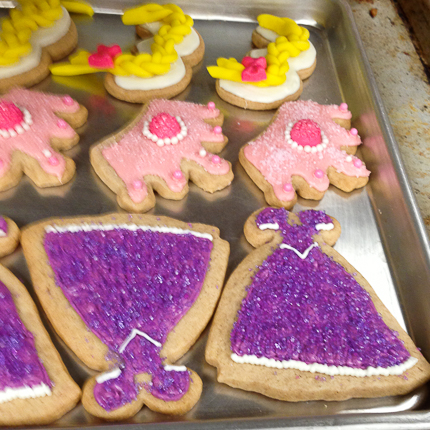


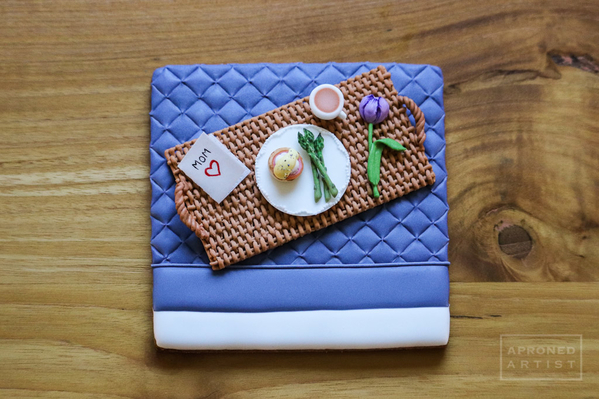


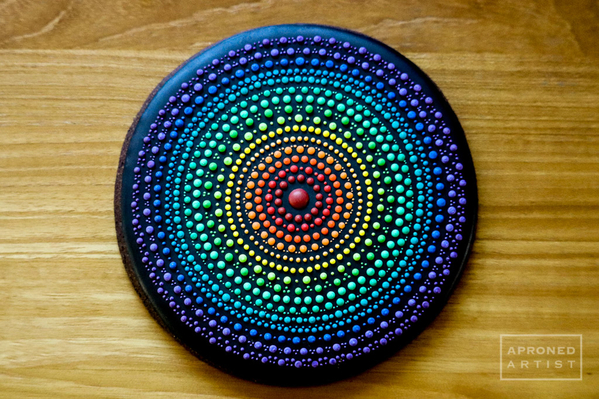
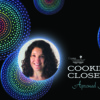

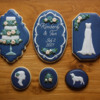

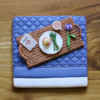

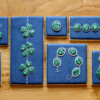

Comments (13)